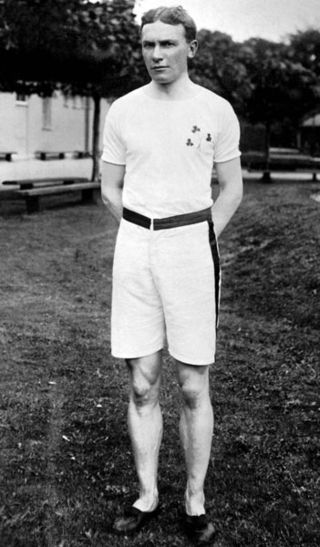Related Research Articles

Robert Kerr was an Irish Canadian sprinter. He won the gold medal in the 200 metres and the bronze medal in the 100 metres at the 1908 Summer Olympics.

At the 1908 Summer Olympics, a polo tournament was contested. It was the second time the sport had been featured at the Olympics, with 1900 being its first appearance. The venue was the Hurlingham Polo Grounds in London. The Hurlingham Club presented a Challenge Cup to the winner of the tournament, which consisted of three teams. All three teams represented the British Olympic Association, with two from England and one from Ireland. The two English teams played each first, with the winner playing against the Irish team. Roehampton won both games, taking the gold medal, while the other two teams did not face each other to break the tie for second place.

At the 1908 Summer Olympics, a field hockey tournament was contested for the first time. Six teams entered the tournament: England, Ireland, Scotland, Wales, Germany and France. England won the gold medal, Ireland the silver and Scotland and Wales were awarded bronze medals. All the medals were subsequently credited to Great Britain.

The men's double York round was one of three archery events on the archery at the 1908 Summer Olympics programme. Arrows were shot in ends, or groups, of three. The archers shot a total of 288 arrows each over the two rounds of 144. The competition was held on Friday, 17 July and Saturday, 18 July, with one round each day. The archers had to contend with significant rain and wind on the first day and gusts of wind on the second.
Oscar Jay was a French archer. He competed at the 1908 Summer Olympics in London. Jay entered the Men's Continental Style event in 1908, taking 17th place with 134 points.
Dora Honnywill was a British archer who competed at the 1908 Summer Olympics in London. She was born in Benenden. Honnywill competed at the 1908 Games in the only archery event open to women, the double National round competition. She took fifth place in the event with 587 points.
Ethel Isabel Armitage was a British archer. She competed at the 1908 Summer Olympics in London. She was born in Salford, Greater Manchester. Armitage competed at the 1908 Games in the only archery event open to women, the double National round. She took 6th place in the event with 582 points.
Lizzie Foster was a British archer. She competed at the 1908 Summer Olympics in London. Foster competed at the 1908 Games in the only archery event open to women, the double National round. She took 7th place in the event with 553 points.
Gertrude Appleyard was a British archer. She competed at the 1908 Summer Olympics in London. Appleyard competed at the 1908 Games in the only archery event open to women, the double National round. She took 11th place in the event with 503 points.
Lillias Robertson was a British archer. She competed at the 1908 Summer Olympics in London. Robertson competed at the 1908 Games in the only archery event open to women, the double National round. She took 13th place in the event with 500 points.

Katherine Gwen Mudge was a British archer. She competed at the 1908 Summer Olympics in London. She was born in Llanbedr, Gwynedd in Wales. She was a member of the Devon and Cornwall Archery Society. Mudge competed at the 1908 Games in the only archery event open to women, the double National round. She took 17th place in the event with 465 points.
Ellen Mabel Liederskron Babington was a British archer. She competed at the 1908 Summer Olympics in London. Babington competed at the 1908 Games in the only archery event open to women, the double National round. She took 18th place in the event with 451 points.
Martina Hyde was a British archer. She competed at the 1908 Summer Olympics in London. Hyde competed at the 1908 Games in the only archery event open to women, the double National round. She took 20th place in the event with 419 points.
Janetta Vance was a British archer. She competed at the 1908 Summer Olympics in London, in the only archery event open to women, the double National round. She took 23rd place in the event with 385 points.
Emily Jane Rushton was a British archer. She competed at the 1908 Summer Olympics in London. Rushton competed at the 1908 Games in the only archery event open to women, the double National round. She took 24th place in the event with 323 points.
Denis Bernard Murray was an Irish athlete, who competed at the 1908 Summer Olympics in London.
Emilio Brambilla was an Italian athlete.
Giuseppe Tarella was an Italian athlete. He competed at the 1908 Summer Olympics in London. He was born in Turin.
Joseph Michael Lynch was an Australian long-distance runner. Lynch was born in 1878 in Darlington, Sydney. He was the youngest son of Irish immigrants John Lynch and Mary Hassett.
Charles Edward Swain was an Australian athlete. He competed in the 1908 Summer Olympics in London on the Australasia team, a combined squad of competitors from Australia and New Zealand.
References
- ↑ "Hugh Percy Nesham b. 17 Jan 1878 Kingston-on-Thames d. 26 Jun 1923 Surrey, England". www.laing.net.au. Retrieved 5 February 2021.
- ↑ "Hugh Nesham". Olympedia. Retrieved 25 February 2021.